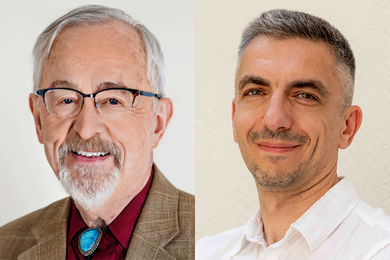This week the Boston Symphony Orchestra undertakes the world premiere of John Harbison’s sixth symphony, which it commissioned with the encouragement of its famous former conductor James Levine, a longtime supporter of Harbison’s work. Harbison, an Institute Professor at MIT, wrote the symphony in 2011, and spoke this week with MIT News about the nature of the piece and the effort it takes to compose a major new work.
Q. One distinctive aspect of your new symphony is that it begins with a song based on James Wright’s poem, “Entering the Temple in Nimes.” You’ve said that the poem, to you, represents “steadfastness and endurance.” Could you say why, thematically and musically, you decided to start it this way?
A. It represents a little bit more explicitly what I thought was the subject matter of the symphony. The commissioner of the symphony is the Boston Symphony and its then-music director James Levine, but he’s been unable to conduct this year. That somewhat colored my sense of the tone of the symphony and I wanted to have some emblem of that at the beginning of the piece. There have been symphonies that have introduced voices at the end, but here I wanted it to be more like a theme than like a summation.
Levine was very primary in conceiving it, and obviously there’s a sense of a loss that he wasn’t able to continue and conduct it, and I was feeling that very much in the summer when I was working on it. And there’s a longer association, dating back 20 years, of writing pieces for him and learning a lot about both my own music and music in general, and I think that colored it more than I expected. It’s partly the reason I changed course and did a lot of refashioning of this piece when it was almost supposed to be finished.
Q. What was the composing process in this case, then? It sounds as if this symphony was not written in the sequence that became its final form.
A. As it turns out, no, it wasn’t. I had pretty much the entire piece in outline when I decided to take the first quarter out, and replace it with the song. At that point, that was the last composing I had done, but I felt like I had to reattack the other three sections as well. So there is a lot of reference to the song … I moved a lot more things in and out of order than I usually do, and wound up with different sections of the piece referring to each other more. But in the end, what I’m always trying to come out with is something that sounds like it was the way I thought of it originally. And I think a lot of what I’m doing when I’m composing is trying to decide when something should happen. Sometimes what I initially think is a beginning turns out to be much more suitable to be presented later on. The longer I’m working as a composer, the more disorder I admit to in the process.
Q. How different is it to work on a symphony compared to other types of compositions? From the outside, it appears to be an undertaking of much greater magnitude. But given that you’ve written six of them, do you find that to be the case?
A. I think there is a sense that putting the title “symphony” on a piece puts a claim to sustained thought on it, or that it’s supporting a certain amount of content. That can be bracing and exhilarating and probably a valuable part of the experience. But I have written pieces more generally, even in the case of these symphonies, where I didn’t know they were symphonies until they were pretty far along. I wrote a piece right after I finished my big opera, “The Great Gatsby,” which I was thinking might be a symphony, but at a certain point I realized it was a piece called a partita, which in musical terms is a somewhat lighter piece that has dance origins. The sense that it wasn’t a symphony, and was a partita, emerged as I was working on it. So it both disqualified itself as a symphony and felt very much welcome in that other description. The classification can be something that emerges in the process of working. I think that’s true of a lot of projects.
Q. One distinctive aspect of your new symphony is that it begins with a song based on James Wright’s poem, “Entering the Temple in Nimes.” You’ve said that the poem, to you, represents “steadfastness and endurance.” Could you say why, thematically and musically, you decided to start it this way?
A. It represents a little bit more explicitly what I thought was the subject matter of the symphony. The commissioner of the symphony is the Boston Symphony and its then-music director James Levine, but he’s been unable to conduct this year. That somewhat colored my sense of the tone of the symphony and I wanted to have some emblem of that at the beginning of the piece. There have been symphonies that have introduced voices at the end, but here I wanted it to be more like a theme than like a summation.
Levine was very primary in conceiving it, and obviously there’s a sense of a loss that he wasn’t able to continue and conduct it, and I was feeling that very much in the summer when I was working on it. And there’s a longer association, dating back 20 years, of writing pieces for him and learning a lot about both my own music and music in general, and I think that colored it more than I expected. It’s partly the reason I changed course and did a lot of refashioning of this piece when it was almost supposed to be finished.
Q. What was the composing process in this case, then? It sounds as if this symphony was not written in the sequence that became its final form.
A. As it turns out, no, it wasn’t. I had pretty much the entire piece in outline when I decided to take the first quarter out, and replace it with the song. At that point, that was the last composing I had done, but I felt like I had to reattack the other three sections as well. So there is a lot of reference to the song … I moved a lot more things in and out of order than I usually do, and wound up with different sections of the piece referring to each other more. But in the end, what I’m always trying to come out with is something that sounds like it was the way I thought of it originally. And I think a lot of what I’m doing when I’m composing is trying to decide when something should happen. Sometimes what I initially think is a beginning turns out to be much more suitable to be presented later on. The longer I’m working as a composer, the more disorder I admit to in the process.
Q. How different is it to work on a symphony compared to other types of compositions? From the outside, it appears to be an undertaking of much greater magnitude. But given that you’ve written six of them, do you find that to be the case?
A. I think there is a sense that putting the title “symphony” on a piece puts a claim to sustained thought on it, or that it’s supporting a certain amount of content. That can be bracing and exhilarating and probably a valuable part of the experience. But I have written pieces more generally, even in the case of these symphonies, where I didn’t know they were symphonies until they were pretty far along. I wrote a piece right after I finished my big opera, “The Great Gatsby,” which I was thinking might be a symphony, but at a certain point I realized it was a piece called a partita, which in musical terms is a somewhat lighter piece that has dance origins. The sense that it wasn’t a symphony, and was a partita, emerged as I was working on it. So it both disqualified itself as a symphony and felt very much welcome in that other description. The classification can be something that emerges in the process of working. I think that’s true of a lot of projects.






